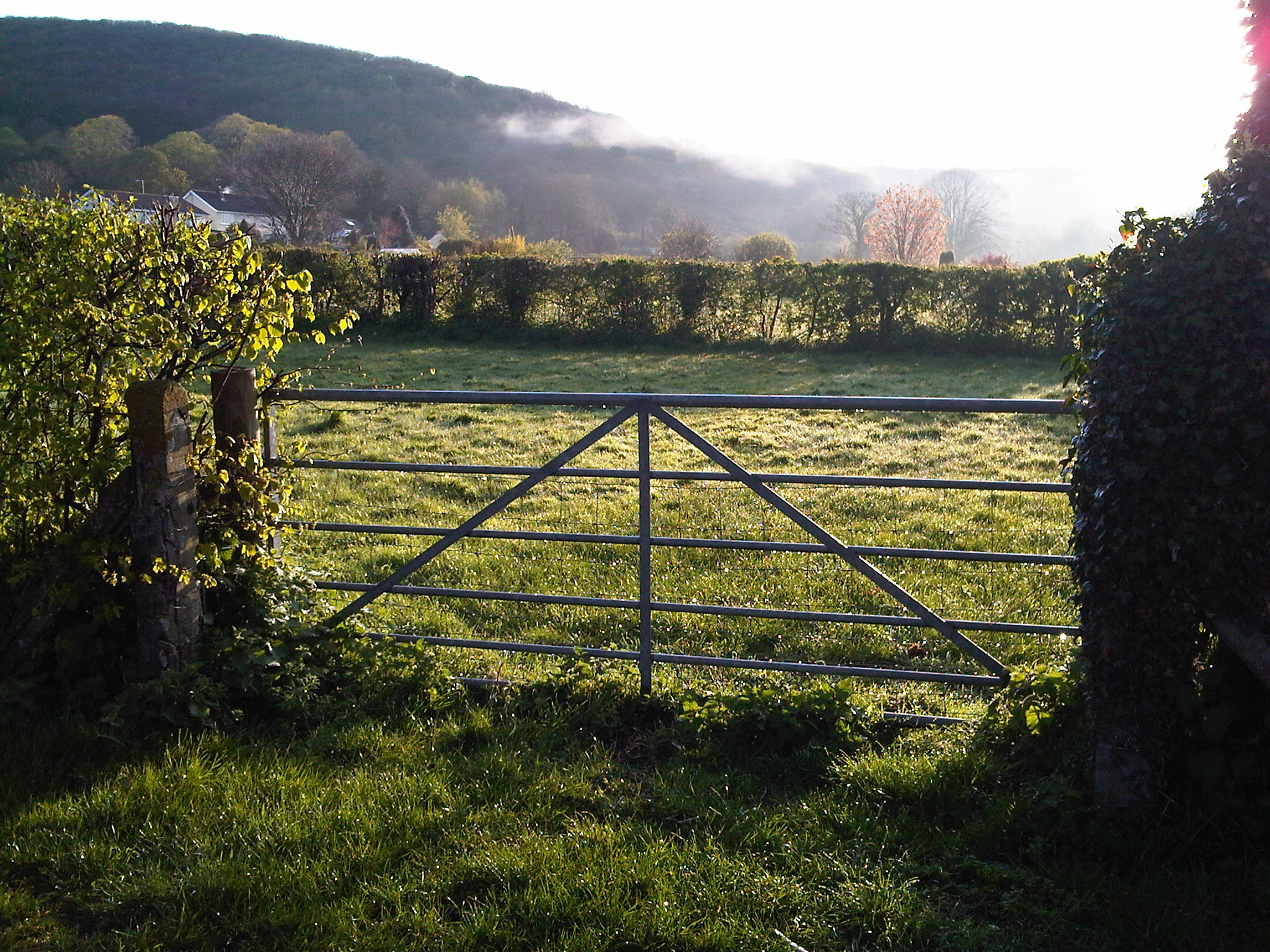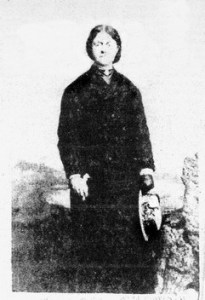
Fashion: the model India poses in Banwell to echo the life and love of music of the eccentric Miss Emily
STRAWBERRY LINE TIMES – FEATURE: She loved men in uniform and formed Banwell’s fire brigade – the strange world of Miss Emily Fazerkerley
One lived in a haystack, one joined the Serbian army and another set up her own fire brigade. The world would be a much duller place without that most individual of human beings: the female eccentric. Harry Mottram reports.
Flora Sandes was the only woman from Britain to join the Serbian army and fight the advancing Austrians in the First World War. Louisa (no known surname) lived in a haystack near Congresbury in the late 18th century and for a time was something of a celebrity with fashionable visitors riding out to visit her. And finally we have Emily Fazakerley from Banwell. Born in Ynys Mon, Cymbru (Wales), in 1840 she was the daughter of Henry Fazakerley of Fazakerley House Lancashire, and lived in Plas Castell at Denbigh Castle and was educated in London. Emily moved to Banwell Abbey in 1883 for health reasons and was to leave a lasting impression when she arrived by train on the Strawberry Line at Banwell and Sandford Station. Looking slightly severe in her funereal black gown the Welsh aristocrat cut an exotic image of a cross between Mary Poppins and Queen Victoria.
Banwell’s centre: the narrow streets of the village seen in 2012
Described as a “wealthy, eccentric, lady bountiful” on Barry Mather’s website about the history of Banwell, the wealthy spinster of the parish was noted for her acts of generosity to the community. These included donating land and a cottage to set up a fire station in 1887, and buying a horse drawn fire engine and uniforms for the new fire brigade. Clearly Emily had an eye for theatre as she established a brass band and had special uniforms for the musicians made by Mr Lewis the village tailor. Once she had moved into the Abbey in Banwell (now split into four homes) Emily took a keen interest in the social life of the village. In the 19th century the village was like many in England – suffering from unemployment and in particular a lack of social services. Although the Education Act of 1870 had begun to provide elementary state education there was no formal provision for training and further education. Poverty was a problem and the utilities, health service and emergency services we take for granted barely existed.
Shopping street: the centre of the village in 1910
It was recorded that: “On a sudden whim, she would invite all the women in the village to tea and they, numbering as many as 50, would march through the village escorted by the band. They were not only entertained to tea but sent home loaded with blankets, sheets, tea and every kind of household utensil – to the value of about £50 (a considerable sum in those days). When a tinker called at the Abbey she would sometimes purchase his entire stock – brushes, pans etc. to build up her stock of gifts to give to the village.” Many homes were still thatched and all houses used open fires – so the threat of fire was considerable to the tightly packed homes of the village.
Emily decided to set up a fire brigade complete with a fire station and the latest equipment. And her philanthropy didn’t end there. Emily also founded a village band – dressing the members in smart uniforms and equipping them with musical instruments. One of the band – the late Fred Day – recalled “Miss Fazakerley took a great interest in the band and invited it to play at the Abbey on many occasions – we used to go there nearly every night. We didn’t know many tunes and were not much of a band, but we used to struggle through two or three numbers such as Rule Britannia. However, she seemed very pleased with us and after we had played would call out to the Butler “Cornelius, march them to supper”. And what a supper it was.”
Eccentric lady: the only photograph we have found of the unusual resident
Cornelius the butler was also called upon to set light to bonfires in the grounds of the Abbey – so she could invite the firemen to demonstrate how effective they were. Whether these were official hoax calls is unclear – but then if you’ve paid for the fire brigade’s creation it is only fair you can call them out occasionally for your own amusement. Another passion of the extraordinary Miss Fazakerley was her legendary shopping trips to Bristol where she would sometimes hire a special steam train on the Strawberry Line. Setting off from Banwell and Sandford Railway Station accompanied by her staff and waited upon by Cornelius the butler she visited the chic shops of Bristol’s Corn Street, Victoria Street and Castle Street – no doubt stopping for lunch at the Tudor Dutch House on the corner of Wine Street and High Street.
Home ground: Miss Fazakerley’s house is still standing – now a set of flats
The friend of tinkers and the poor, founder of fire stations and village bands it seemed the eccentric Miss Fazakerley could do no wrong. That was until the incident of the church clock in 1884. It was one innovation too far. St Andrew’s parish church was in need of a new clock and so in her own individual way Miss Fazakerley had one brought from her family home in Denbigh Castle and paid for the workmen to have it installed on the church tower. Lit by gas which automatically switched on at night it appeared to be the perfect timepiece. However this was the 19th century and folks weren’t so keen on all modernisations. It would be the equivalent of a vast digital clock being put there today along with neon lighting. It would do the job but somehow not in the right way. The villagers took against the new clock and made their feelings felt.
It must have been a painful moment in the relationship between the parishioners and Emily – but she got the message and had the clock removed. A short time late the villagers replaced it with a clock of their own choosing – which is still there to this day. Oh well… you can’t win them all. In 1888 Miss Fazakerley died at the age of 48. Her death stunned the village with the residents in genuine shock. Her frail and imp-like body was laid in an oak and lead coffin and placed in state in the Abbey chapel. Hundreds of mourners visited the coffin to pay their last respects – an act of homage that has largely disappeared in our own times.
Her final journey was fittingly by horse and carriage to Banwell and Sandford station where her coffin was taken to London to be buried in the family plot. But it was a departure that combined her two defining characteristics: public theatre and community spirit. Accompanied by the Banwell Fire Brigade and of the village brass band hundreds of mourners made up of residents, family members and friends walked at funereal pace the mile or so to the station while in the distance could be heard the tolling of the church bell – rung in her honour.
Square view: the centre of the village around 1900
One obituary recorded: “To give a general estimate of her character is a pleasing and by no means a difficult task. The impression that has gone abroad concerning her, needs modification. Her eccentricities and naturally excitable temper left sometimes a wrong impression. Her very follies leaned to virtue’s side. Her failings were her virtue. She was generous even to a fault. Her concern for the poor during the recent very severe weather was sometimes painful to witness. She had an idea that they were dying of hunger and cold and that she must provide them with soup, bread, meat, coals and clothing.
Her one aim was to do well, and had her life been spared she would have done still more good. As it is, she has left her mark upon Banwell so deeply engraved that while one of the present inhabitants still survive, her name will be held in grateful remembrance. Well may it be said ‘She was a lady, take her for all in all, we shall not look upon her like again’.” At the beginning of this article I called Emily a Great British eccentric – or words to that effect. But perhaps she was not an eccentric but rather an individual. Are not eccentrics simply people who do as they wish and are not bothered by the opinions of others and the conventions of society? Individuals who are happy as themselves. Why we need to pick on them is perhaps more to do with the fact that most of us are not particularly unusual. We blend in almost unnoticed in society – which is the way we like it. While Emily was certainly an individual – and although she was rich and could do as she chose – you don’t have to be wealthy to be called an eccentric as Louisa in the haystack proved – a lady who we may well revisit in a future issue.
Acknowledgements to Roy Rice of Banwell on his history of the Banwell Fire Brigade.






